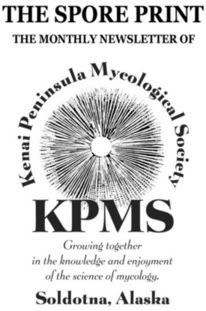Issue 12, November 2006
I would like to thank all those who have contributed articles and photos. They have been very much appreciated. Keep them coming!
OUR NEXT MEETING WILL BE ON SATURDAY, NOVEMBER 11TH, AT 1:00 P.M., IN THE COOK INLET AQUACULTURE BLDG. (40610 K-BEACH ROAD, KENAI).
I think we would all agree that the mushrooming season here on the Kenai Peninsula is over for this year. With the frosty mornings and steadily cooling temperatures it would be reckless, foolhardy (and very unwise) for any mushroom to poke its cap up out of the ground now!
Reflecting back over the summer, I would say that (all things considered) it was a very good season. It started off poorly, but finished up with a bang!
Our first foray to Skilak lake produced almost nothing and our second foray to Caine’s Head State Park in Seward was little better. Then, we finally began to get some rain. We met at Soldotna Creek Park to begin and end our next two forays and each time we nearly filled two or three of the tables with the mushrooms that were collected! Dominique did an excellent job of walking us through the specimens and identifying them for us.
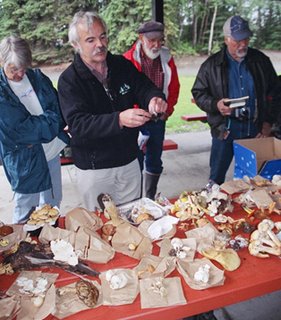
We also had an additional spur-of-the-moment gathering (again, under the covered picnic area at Soldotna Creek Park). It was very short notice and miserable, wet weather, but the turnout was great and everyone came loaded down with specimens. I brought along my two burner propane stove, Dominique supplied the skillets, someone produced a huge tub of potato salad, there were paper plates, plastic silverware and we even had two bottles of homemade wine! After separating out the edible species, Dominique cooked them up for everyone to sample.
It was a great summer. I learned a lot, made some new friends and had a good time. I think that many others could say the same.
For our October meeting we returned to the CIAA building. The fruiting season was nearly over, but everyone was encouraged to bring any specimens they could find. The turnout was good and there were a lot more specimens collected and a greater variety than I had expected.
Instead of our usual identification session, each person present was given two mushroom species and asked to identify them. It was encouraging to see how many folks were successful, especially since no information was given with the mushrooms when they were passed out!
If we were to do this again, I would want each person to know the spore print color of their specimen. I say this because of my own experience. I was handed one specimen that I did not recognize. It had the stature characteristics common to at least a dozen different genera, and because I didn’t have a spore print, I had no way to shorten my list and narrow my search.
As a consequence, I found myself thumbing through my field guides hoping to find a photo of my specimen. This is a dubious (if not downright dangerous) practice, and one I generally try to avoid. Knowing the spore print color would have eliminated a lot of my confusion.
Here is an e-mail I received from Blanche Tinius, a long-time mushroomer and KPMS member from Eagle River. Blanche and her husband Jim, attended the NAMA foray in Hinton, Alberta, and I asked her if she would be willing to share some of that experience with us.
2006 NAMA annual Mushroom Foray
Hinton, Alberta - August 17, 18, 19 & 20.
Hosted by the Edmonton Mycological Society
130 members attended the foray, basking in sunshine and warm temperatures in the 70s and 80s, while Alaska was being drenched by heavy rain. There were 23 States and 4 Canadian Provinces represented. But, as has been the case in so many other forays my husband and I have attended, we were the only Alaskans present. The International Mycological Conference in Australia coincided with the NAMA foray, so there were fewer mycologists present than normal.

Blanche with Hope Miller, who is signing her copy of North American Mushrooms.
The foray was shrouded in sadness over the death of Dr. Orson Miller, who was to have attended. Losing Dr. Miller is a tremendous loss to the mycological world, as well as to his family and friends. His wife, Hope did attend the foray and signed their latest book North American Mushrooms for members who had obtained the book.
There were 16 educational programs offered at the foray, including workshops in photography, paper making, mushroom cultivation and a beginner’s class. There were also a number of presentations. Topics included mushroom toxicity, northern mushrooms, Gulf Coast fungi, unusual fungi, mushroom inhabiting insects and fungi for medicinal purposes. A number of the presentations were taped and DVDs could be purchased at $20 each.
There were 18 forays to various places, ranging from easy to difficult. One of these forays included a stop at Miette Hot Springs in Jasper National Park, where some of the members chose to relax in the mineral springs rather than continue foraging for mushrooms. Another interesting foray was to the Cardinal Divide, which was at an elevation of 7000 feet. It was difficult terrain, but there was lots of wildlife to be seen.
The evening meals were accompanied by presentations and slide shows. After the evening meal, those wishing to return to the Miette Hot Springs for a relaxing soak could catch a waiting bus.
As at all forays, there was a mycophagy session where a number of different species were prepared in various ways and served to the members. It always amazes me, that at these forays we break our own rules. We tell people to eat only one species at a meal so that if there is a reaction, it can be determined which mush-room was the culprit. We also caution that consuming alcohol along with mushrooms can sometimes cause reactions. Yet, at these forays, members consistently consume a number of different species, often along with an alcoholic beverage. Perhaps, when giving this advice, we should tell people “don’t do as I do, but as I say.”
The foray ended with a walk around all the tables by a Mycologist who talked about the mushrooms on display. There were well over 200 different species catalogued. These specimens will be preserved (along with all the related information) and placed in the NY Botanical Gardens. This information will also be shared with the Canadian Government.
These forays are not only very educational, but you meet and get to know many mycologists. They are always willing to help you, and not only at the forays, but whenever you need assistance. You also meet up with old “mushroom” friends and make new ones. It’s an excellent opportunity to exchange information and there are always fungi collected that you don’t find in Alaska or have never seen before.
The next NAMA annual foray will be at Pipestem, WV, Aug 16 - 19th. 2007. I would encourage you to attend and find out for yourself how educational and fun these forays really are.
Blanche also sent the following photo which was taken by her neighbor Scott Amy. My first thought was that this was the south end of a naked, north bound extra-terrestrial, sneaking along on all fours. Then, I began to wonder if there wasn’t a more rational explanation (like someone’s poor pet cat or lap dog had been drinking out of a barrel of toxic waste and lost all its hair and a number of its appendages).
But, it turns out that this ‘creature’ is not other-worldly or the product of some chemical brew. This UFO (unusual fungal oddity) is a common Alaskan mushroom. This is an excellent example of how drastically environmental factors can affect the growth of a mushroom.
November Mushroom Of the Month

This mushroom of the month has two prize categories. If you are the first to correctly identify the genus and species you will receive an English china coffee mug bearing a woods scene which includes a number of fungi. In addition, Blanche has offered to donate an 18” x 24” color poster featuring an Alberta mushroom, Leccinum boreale, for the best and most original whimsical genus and species name given to this mushroom. Since she will be providing the prize, I will forward all entries to her and she will pick the winner.
Ken Gill was our October Mushroom Of The Month winner. He was the first to correctly identify the mushroom in the photo as Agaricus Silvaticus, and will receive a Churchhill china coffee mug for his efforts.
I am somewhat confused on the identification myself, and would have accepted either A. silvaticus or A. haemorrhoidarius as the correct answer. The specimen stained quickly bright cherry-red when cut and remained pinkish-red for a considerable length of time, a characteristic of A. haemorrhoidarius, while A. silvaticus stains more slowly and then quickly fades to brown. You would think that would have been enough to settle the matter, but it appears that the various 'authorities' are not even in agreement. Some claim to have found A. haemorrhoidarius in Alaska, while others say that it occurs only in Europe and that our A. haemorrhoidarius is really just a variant of A. silvaticus. It seems that the spore size is at the heart of the issue with A. silvaticus having larger spores. But, even this distinction appears to be somewhat clouded. So, I decided to accept either answer.
The October Mushroom Of The Month

It may come as a surprise to some, that KPMS has members in such far-flung places as Florida, Missouri, Colorado and Montana. Some of these members correspond regularly, and I asked two of them, Steve Dziekan (central Colorado) and Dick Johnson (northwestern Montana), if they would be willing to share with us something of their mushrooming experiences this last season. Both Steve and Dick were gracious enough to respond.

Steve Dziekan, with a nice collection of yellow chanterelles. The dark patch in the corner of his red basket is a clump blue chanterelles (Polyozellus multiplex). Steve is not only a KPMS member, but a long-time member of the Colorado Mycological Society.
Steve - May started out wet and just when the yellow morels started popping up in large numbers, it dried up and ruined what would have been a banner year. In the northern and central mts. it was the rainiest July and August that I have ever seen, as well as the coolest and the weirdest. The kings came out before the Leccinums, but were plentiful. It was almost too cool for the chanterelles, but I managed to pick and process about 25 lbs. Big clusters of Polyozellus multiplex, oysters and Chroogomphus, but not many Hydnum repandum, (which means less than the few patches that I usually find. All and all, it was the best year in the last 4 or 5. There were also nice clusters of Flammulina velutipes and various Agaricus. We also had a fairly good ‘hawkwing’ year. There are a lot of species of Sarcodon in Colorado, some with very small wings and one with barely an indication of scales and a smooth cap that is somewhat shiny and grayish-brown. All are bitter, with the exception of S. imbricatus.
Take care, Steve

Dick Johnson at a foray in western Montana. The pretty young lady in the foreground is one of my granddaughters, and quite an avid mushroomer, as well. Dick is the long-time president of the Kootenai Valley Mycological Society in Libby, Mt. and a member of the Pacific Northwest Key Council. (Ian Gibson, who produces MatchMaker is also a member of the Key Council.)
Dick (from a recent phone conversation) – Our first outing of the season was a Key Council foray in late May at Tall Timbers, a church camp near Lake Wenatchee in north- central Washington. Though this area can produce an abundance of ‘natural’ morels, it was very dry and we found very little of anything.
The ‘naturals’ were pretty good in northwest Montana. There were no local fires the previous season so the only ‘fire’ morels were in a few Forest Service ‘prescribed burns’. There were some corals, but not the buckets-full that you can pick in a good year. There were no early king boletes, and I did not find any in the fall, either.
The spring was followed by a very hot, dry summer with the only edibles being a few Suillus and an occasional Russula, Agaricus bitorquis or A. silvicola.
(Dick also reminded me of the account of a fatal poisoning attributed to Russula nigricans – Russula previously being considered a ‘safe’ genus with a few species which would, at worst, cause severe intestinal discomfort.)
We had some rain in the late summer and early fall. The chanterelles were spotty with both the yellows and the whites fruiting well in some areas.
The annual Priest Lake, Idaho foray sponsored by the Spokane Mushroom Club was well attended. There was the usual assortment of mushrooms, although no king boletes turned up and the chanterelles and matsutakes were less abundant than normal.
The last three seasons have been hotter and drier than normal resulting in far fewer chanterelles and matsutakes than in previous years.
One of the benefits of KPMS membership is that you are able to purchase several excellent books at a greatly discounted price through the club. Here is what we have to offer.
We struck a deal with Lone Pine Publishing and are able to get a 40% discount on their books. Lone Pine Publishing has a couple of excellent mushroom field guides we can offer our members at our cost plus shipping. Both are tremendous guides and include many of the species in our area.

There are still a few copies of Orson Miller’s North American Mushrooms available. Our ‘member’ price is $15.00.
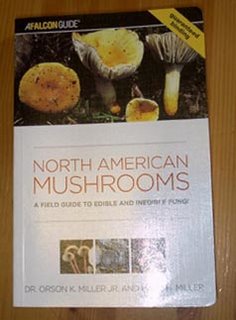
We are placing another order for Arora’s Mushrooms Demystified and All That The Rain Promises and More. They will be available at our cost (to members) - $23.00 for MD and $15 for ATTRPAM. (With this order, it will make over 100 copies of these two books that we have purchased!)
I have three copies of A Field Guide to Southern Mushrooms, by Alexander Smith. These are new books that I got from a friend who is a book dealer. I will sell them at my cost, $13.00 each. If you spend any time in the southeastern U.S. it is an excellent resource.
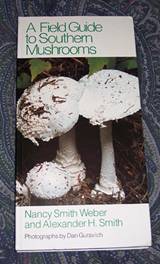
If you are interested in any of these books, let me know or talk with Janice Chumley at the November meeting.
KPMS was given a Canon imageClass D600 series copier. This is a very nice unit that is able to make copies up to 11” x 17” in size. Presently we do all our copying at the UPS Store at a cost of about five cents per copy. This copier will allow us to cut our cost to between two and three cents per copy. The donor wishes to remain anonymous, but they have our thanks for this generous gift.

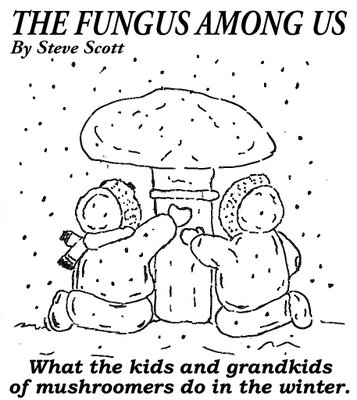
The mushroom identification class I taught for the community school was really a lot of fun. I had an exceptionally great group, and there was a lot of interaction. Six out of that class are now club members!
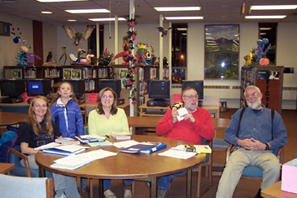
We hope to see you at the Nov. 11th meeting. We will begin a review of each of the ‘gilled’ families starting with those with white spores.
Until then,
Steve
